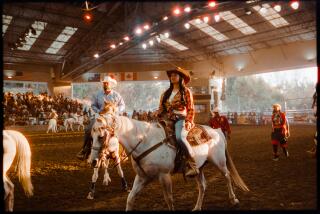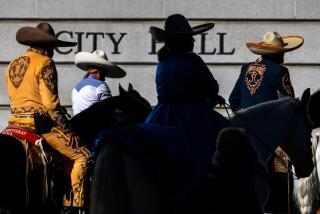Fast Times, Good Times
- Share via
It has been a wicked, wonderful drag race.
And in a half century of hot rodding, an adolescent passion for squeezing speed from discarded cars has risen from back-street activity to accepted Americana. Once an outlaw sport of midnight felonies on Colorado Boulevard, it has graduated to national championships and an industry pitching power packages and six-figure replicas to Beverly Hills buyers.
These chopped and channeled antiques have become, say their historians, a classic of American ingenuity. Like jazz.
“We were a bunch of guys having fun with old cars, changing them, modifying and improving them, exercising the great American freedom to create,” says Gray Baskerville, a builder of hot rods since the ‘50s and junior college and his 1930 Ford coupe with a flathead V-8. “Just like jazz, that began with a bunch of guys having fun with old music, doing their own thing and enjoying a unique form of expression.”
And so, this month marks the demicentennial of hot rodding and a 12-month tribute to be celebrated by a mini-museum of classic gow-jobs and hop-ups at the Greater Los Angeles Auto Show, which runs through next Sunday at the Convention Center. There will be anniversary power tours from California, where the hot rod was refined, to Michigan, where the raw material originated. The first 100 investitures in a Hot Rod Hall of Fame have been announced. Car shops are re-creating and selling legends lost to crashes or mechanical cannibals--and Hot Rod magazine,bible of those who talk stove bolts and small blocks, four barrels and four bangers, has reprinted its maiden edition, plus a special issue marking its first 50 years in business.
The precise origin of hot rodding is foggy.
Purists believe Henry Ford and the Chevrolet brothers may have built the first by lightening, modifying and racing their factory products in the ‘20s. Or was the genesis in the San Fernando Valley in the ‘30s, when the Depression was lightened by kids building cars from junked parts and running speed trials on dry lakes that eventually would be annexed by Edwards Air Force Base and a supersonic breed of hot rod?
Then came Hot Rod magazine in 1948, a pulp-paper tabloid cobbled and stapled together by ad agency partners Robert E. Petersen and Bob Lindsay. In the absence of a definitive date, or certainly any heftier contribution to the sport, the birthday of Hot Rod is generally accepted to be the official nativity of hot rodding.
“It really couldn’t have begun in any place but Southern California,” says Baskerville, who has spent 34 years writing for Hot Rod and is now its senior editor. “The aerospace industry was here with skills in metallurgy and welding--all the things you needed to know to build airplanes that were easily transferred to building cars.
“We had year-round weather; we had movie stars like Gable and Dietrich driving cars customized by Los Angeles coach builders; and we had a bunch of racers and mechanics who were always broke. So they sold their technology to the kid down the street who was building a hot rod . . . $25 for a racing cam, $10 for a hot carburetor.”
In those raw days, lakes racing at El Mirage and Muroc was official, organized and sponsored by local car clubs. Street racing from El Monte to Glendale was unofficial, heavily prosecuted and occasionally fatal.
Hot Rod--now the grandpa glossy in a 75-magazine Petersen chain reaching 50 million readers--was the conduit that brought correctness to the politics of hot rodding.
That first issue acknowledged the public perception of the hobby as “a screwball diversion for a lot of reckless kids . . . an outlet for a bunch of young buckos to blow off steam.” It also threw editorial support behind the Los Angeles Police Department, the Southern California Automobile Club, drag racing events sponsored by the Southern California Timing Assn. and any effort “to put a halt to reckless driving and the use of unsafe motor vehicles.”
In short order, with Hot Rod leading the reformation, came respectability through formation of the National Hot Rod Assn. (NHRA), the Specialty Equipment Manufacturers Assn. (SEMA) and Hot Rod Magazine’s Motorama, now the Greater Los Angeles Auto Show.
“None of us had any idea that what we were doing would become a part of popular culture around the world,” says Petersen, now chairman emeritus of the publications he recently sold. “Not only are there hot rods in virtually every country, but niche vehicles manufacturers built today--like the Plymouth Prowler and the Porsche Boxster--address that same desire for uniqueness that was first expressed by hot rodders.
“Even the mag wheels hot rodders first made popular are found today on everything from sports cars to family sedans to trucks.”
The cover of the first edition of Hot Rod showed a 1927 Model T-bodied roadster that ran to a 136 mph record at El Mirage in 1947. The cover of the latest edition of Hot Rod shows a clone of the same car built for the anniversary by a San Francisco speed shop--one of a dozen retro hot rod builders bringing ‘90s technology and materials to the traditional, gnarly look.
So-Cal Speed Shop at Pomona is another.
It is working on a Chevy-powered, 450-horsepower, steel-bodied, generic Deuce coupe that will be unveiled at a Father’s Day roadster show. Dad should be prepared to shell out $80,000 for the reproduction.
But price, says Pete Chapouris, president of So-Cal, is no huge concern of the modern hot rodder.
“We’ve had people who paid $40,000 for an original hot rod, then spent another $120,000 to have us restore it,” says Chapouris. “The car might still only be worth $80,000, but these people do it for the pure love of hot rods, not the financial gain. In fact, most of the guys I know doing this are at an age where they don’t have time to wait for the gain.
“But they are not part of a trend. . . . They are part of a major passion.”
More to Read
Sign up for The Wild
We’ll help you find the best places to hike, bike and run, as well as the perfect silent spots for meditation and yoga.
You may occasionally receive promotional content from the Los Angeles Times.






